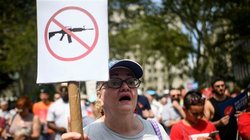 Gun violence in the United States has reached the highest levels in decades and is taking a growing toll the country’s economy, costing the US nearly $230 billion in 2017, according to a new study.
Gun violence in the United States has reached the highest levels in decades and is taking a growing toll the country’s economy, costing the US nearly $230 billion in 2017, according to a new study. RNA - Nearly 40,000 people were killed by firearms in 2017, which included around 2,500 school-aged children, according to the study released Wednesday by Democrats on Congress' Joint Economic Committee.
The report found that US teens and young adults, ages 15-24, are 50 times more likely to die by gun violence than they are in other economically advanced countries.
The report said that in 2017, six in 10 gun deaths in the US were suicides.
“The human cost is beyond our ability to comprehend, it is tragic, it is sickening, and it is a crisis,” US Representative Carolyn Maloney, who is the vice-chair of the congressional committee, said in a news conference Wednesday.
“The gun violence needs to stop and we need to make it happen,” Maloney, a Democrat representing New York City, said.
“Children now go to school in New York with bullet proof backpacks, and do drills in their schools to protect them from gun violence,” she added.
Nationally, the cost of gun violence in the US runs $229 billion a year, or 1.4 percent of the gross domestic product, the report said.
Lost employment represents the biggest cost to the economy, the report notes. Police and criminal justice costs, as well as health care treatment, are among the other major expenses.
The three largest states by population, California, Texas and Florida, bear the greatest absolute costs of gun violence, according to the report. Gun violence costs California $18 billion annually, the report said, followed by $16.6 billion for Texas and $14 billion for Florida.
States like Alabama, Mississippi, Louisiana, West Virginia and Arkansas, which have substantial rural populations, have the high rates of gun ownership and suffer the greatest economic harm from gun violence, according to the report.
It also found economically deprived areas outside of rural America are also hit hard. About 7,500 African Americans die from gun violence every year, the report said — making it 20 times more likely that a young black male will die by a firearm homicide than a white peer.
The gun control debate in the United States was reignited in August after 53 people died in mass killings by firearms in several states.
Polls have shown that nearly half of all Americans expect another mass shooting to happen soon in the country.
Previous attempts to pass gun controls after mass shootings, have mostly failed in the face of fierce lobbying by the NRA and other US gun lobby groups.
847/940